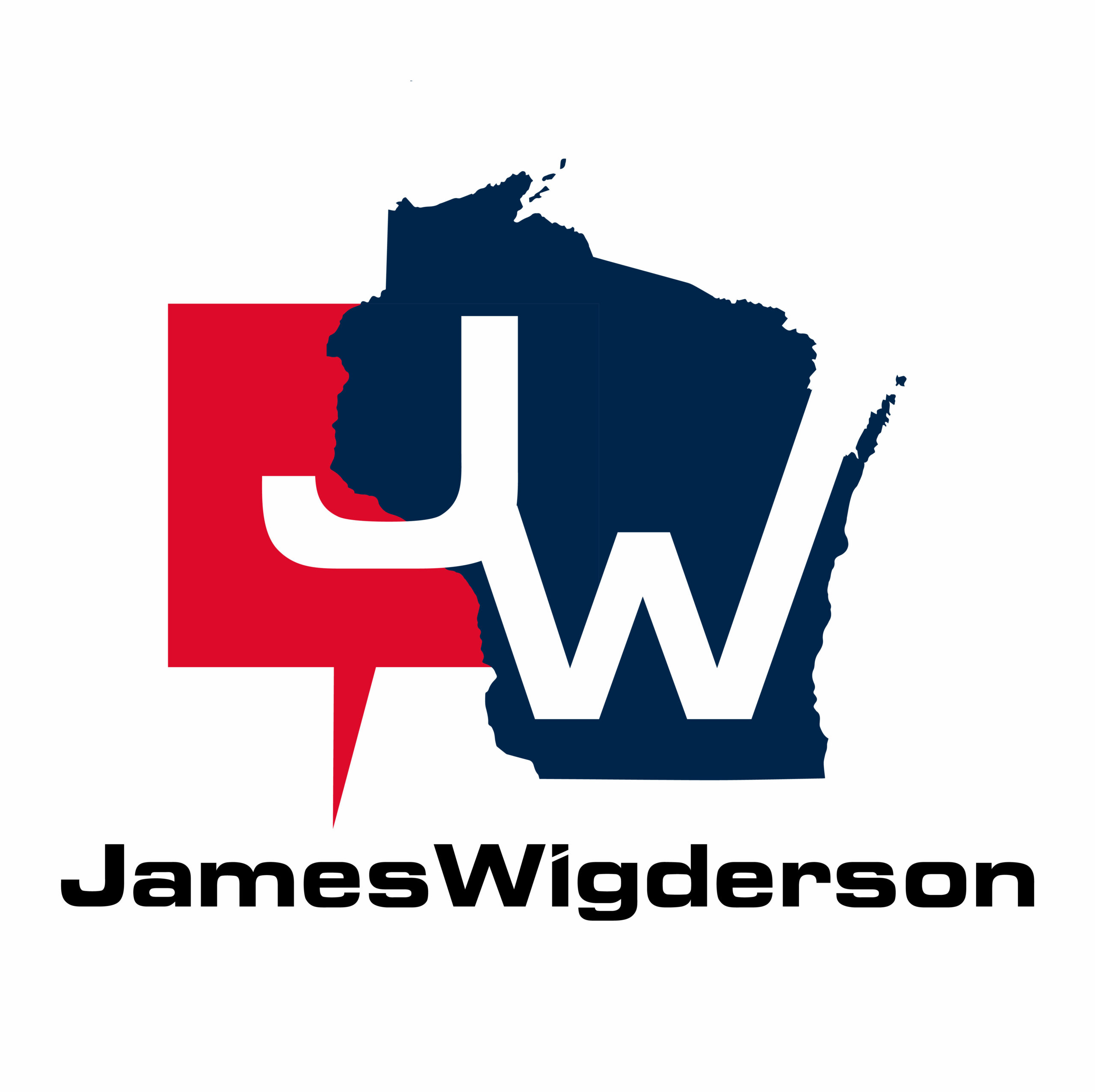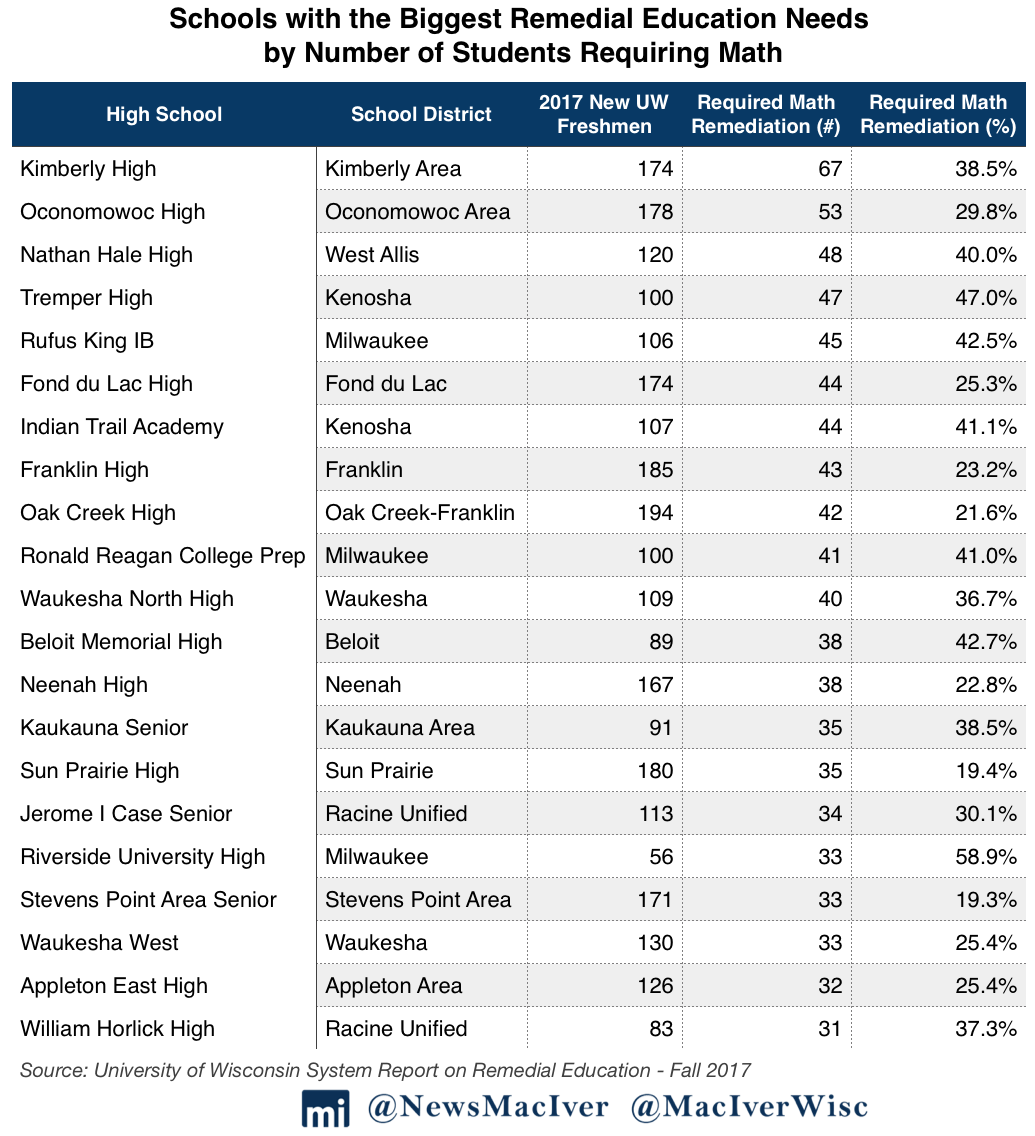- Back-to-school season is upon us, which can only mean one thing. No, it is not the return of blissful quiet to your home. It is time for MacIver’s annual State of K-12 Education Report Card.
- How do Wisconsin’s students, teachers and schools measure up? Are taxpayers receiving a decent return on their investment?
- Nearly 6 in 10 Wisconsin students are NOT proficient in basic math or English – Where is the outrage?
- Despite massive funding increases and flat enrollment, troublesome achievement gaps persist and much, much more.
A MacIver Institute Analysis
According to the state’s Forward Exam, 6 in 10 Wisconsin students are not proficient English language arts or math.
There are many ways to judge individual academic achievement and overall system-wide educational success. Most Wisconsin students in elementary school take the Forward Exam, while high school students take the ACT and Advanced Placement (AP) exams. The state also tracks success by reporting graduation rates and achievement gaps, culminating in annual school and district report cards. Test scores are important, but they aren’t everything. Does a student have access to the school that best fits their needs? If a student graduates from high school and heads to college, is that student prepared to learn and able to graduate in a timely manner? So many metrics, so little time.
We pour over all of this data and condense it down into an analysis that you can then use to decide for yourself – are Wisconsin’s schoolchildren learning what they need to know to be successful after high school and are the schools doing their job well?
Let’s dive in.
Academic Metrics
Graduation Rates
Let’s start with the most common metric used to judge academic success – the rate of graduation from high school. The latest dataset showed that 89.6 percent of Wisconsin’s high school class of 2018 graduated in four years. Students graduated at a slightly higher rate compared to 2017, when 88.6 percent graduated in four years. The figure dipped between 2014 and 2016 but has generally trended upward.

The graduation achievement gap or the diploma gap as it is called between racial and ethnic groups persists, particularly between white and black students. For the class of 2018, 93.5 percent of white non-Hispanic students graduated in four years, while 69.3 percent of black students graduated in the same amount of time — a 24.2-point gap. In 2011, the white-black diploma gap was 27.6 points, meaning the gap has only closed by 3.4 points in seven years.
Hispanic/Latino students have shown the largest graduation achievement improvement of any racial or ethnic group since 2011, when 72.0 percent of students graduated high school in four years. Seven years later, 82.3 percent of Hispanic/Latino students graduate on time, a 10.3-point improvement.
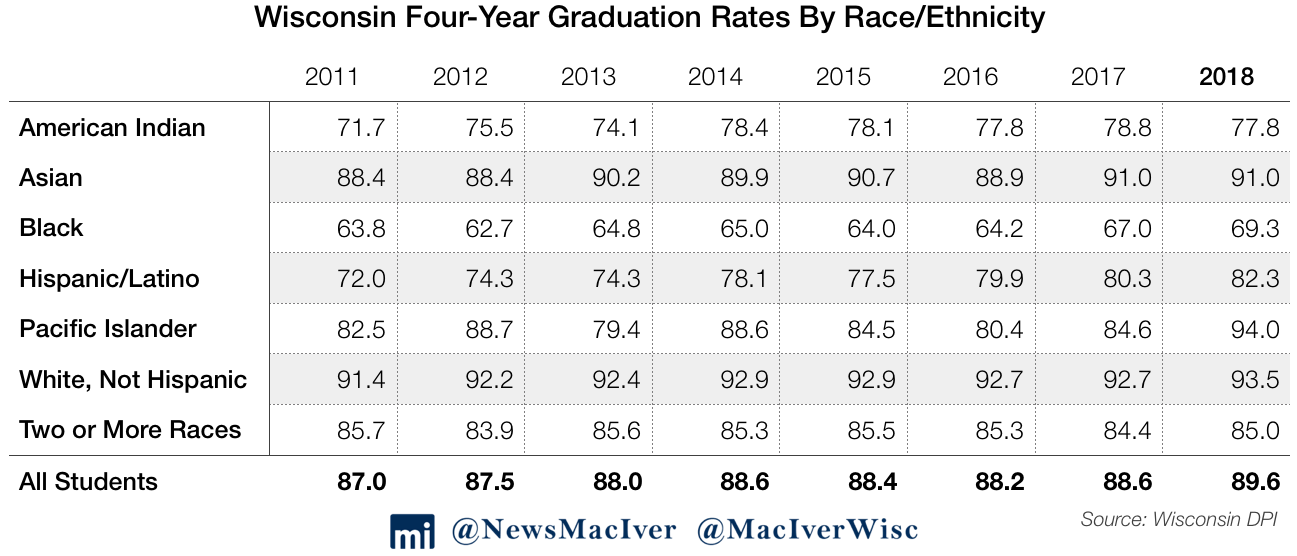
Forward Exam
Wisconsin’s standardized state exam is called the Forward Exam. The Forward Exam measures an individual students’ command of certain basic subjects at different points during their elementary and secondary education. Unfortunately for Wisconsin, the results from the 2018 exam showed that just 42.4 percent of students are proficient in English language arts, and 43.8 percent are proficient in math.
Students improved in math by one percentage point over the prior year, when 42.8 percent were proficient. At the same time, they fared worse in English language arts. In 2017, 44.4 percent of students were proficient on the same exam.
Students showed slight improvement in science, with 49.9 percent of students demonstrating proficiency. That’s up a hair from 49.7 percent in 2017. They also improved on social studies — 50.6 percent of students are proficient in the subject, up a full percentage point from the previous year’s result.
More than 715,000 Wisconsin students in public and private schools took the Forward Exam in March of 2018. The majority of the students who take the exam are in 3rd through 8th grade, as do some 10th graders. Proficiency scores are averages for all students across grades.
Achievement gaps persisted in the data, especially between white and black students. The English language arts gap shrank slightly to 37 points, while the achievement gap in math increased from 39.8 points to 41 points.
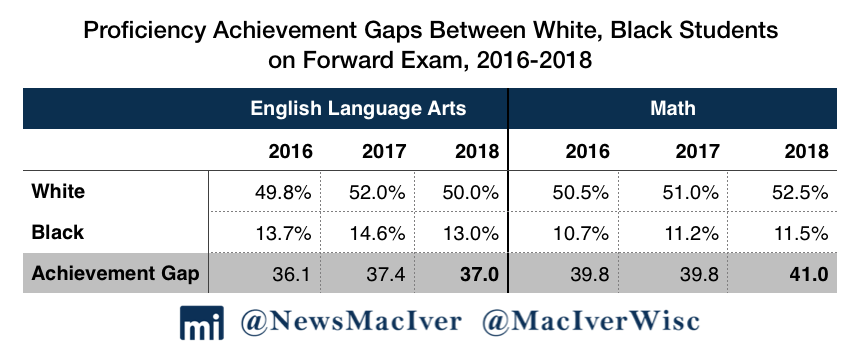
This dataset was released in October of 2018. Results for the 2019 exam will become public this fall.
AP Exams
One bright light in the data shows that more high school students are taking Advanced Placement (AP) Exams, and perhaps more significantly, more students are scoring well on those exams. Students with an AP Exam score of three or higher are awarded college credit at many universities, including in the University of Wisconsin System.
Even as the number of exams taken increased by 2.5 percent in one year, scores also continue to increase. Approximately two-thirds, or 66.5 percent, of AP Exams that students took in May 2018 had scores of three or higher. The previous year, 65.9 percent of exams were scored three or better.
The overall participation rate remains low, at 16.9 percent in 2018, but has gradually increased since 2010. In 2017, 16.4 percent of high school students statewide took an AP Exam.
In terms of overall exams taken, Wisconsin students took a stunning 61 percent more AP Exams in 2018 compared to 2010.
Remedial Education
When students enter the University of Wisconsin (UW) System, they must take placement exams for math and English before freshman year begins. If students don’t do well enough on those placement exams, they are required to take remedial classes before beginning regular college coursework.
Remedial education data show the extent to which the K-12 education system is failing students. Rather than demonstrating mastery of material before graduating high school, thousands of students are moving through the system and arriving at college unprepared.
Thousands of students from Wisconsin high schools have to take remedial classes at the UW System every year. In the fall of 2017, these students came from 197 high schools across the state.
The growing trend of required remedial education highlights that students are graduating from high school woefully unprepared and still being accepted into the UW System.
Plus, the issue compounds many other troubling trends. Students take remedial education classes for full tuition and zero credit. The classes do not count towards degree completion, and students must pass them before moving onto regular coursework. The issue plays into the trend of increasingly high levels of student loan debt, and the amount of time it takes college students to earn a degree—if they finish at all.
Studies show that students who take remedial classes in college are also less likely to graduate, leaving them with thousands of dollars in debt without a degree.
One hundred and eighty-five schools graduated classes where 10 percent or more of the students starting at UW needed remedial math instruction. That’s an uptick from the previous year’s report, which showed that 172 schools graduated classes where 10 percent or more of students needed remediation.
Eleven schools sent classes to UW where 50 percent or more of the students required remedial math. That’s an improvement from 2016, when 15 high schools met that criteria. Of those 11 schools, five are part of the Milwaukee Public Schools district, the largest in the state. At 80 percent, Royall High School had the largest percentage of its graduating class needing math remediation.
Perhaps most troubling in the remedial education report is that many schools on the list ranked highly on Wisconsin’s own report card system. Fifty percent of the high schools who received five stars on Wisconsin’s 2018 report cards graduated students who needed the remedial classes. On average, Wisconsin’s “best” high schools graduated classes where 21 percent of students who entered the UW System required math remediation. Those 222 students come from all over the state – Brookfield, Tomahawk, Shorewood, Kenosha, Milwaukee, and many others.
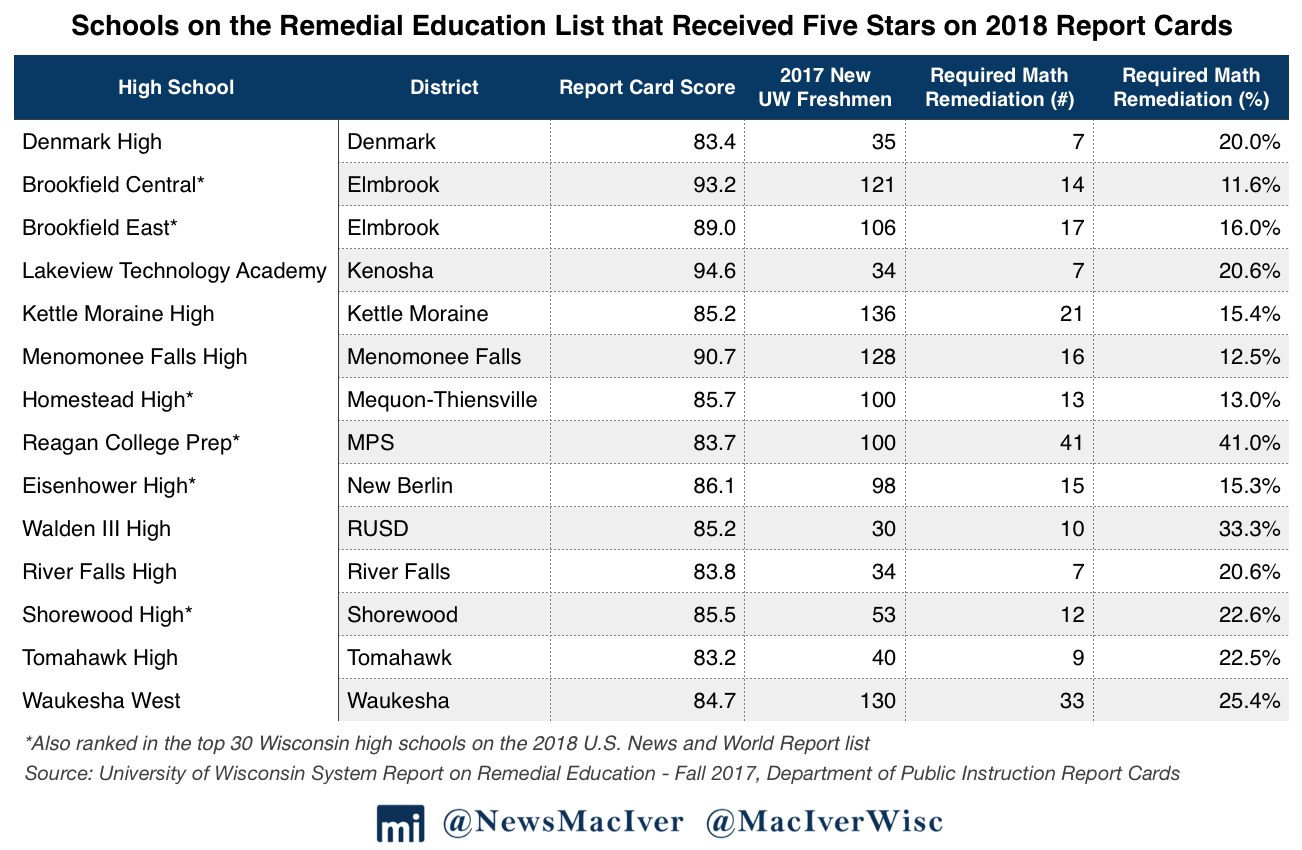
Fourteen schools that sent high numbers of unprepared students to the UW System received ranks of five stars, or “significantly exceeds expectations,” on Wisconsin’s 2018 report cards. That’s a significant increase from the prior year’s list, which showed that nine schools with significant remediation needs had received five-star rankings on the most recent report cards.
Others still were included on notable lists such as U.S. News and World Report and are purportedly among the best schools in the state and country. Eisenhower High School in New Berlin was ranked the second-best high school in the state by U.S. News and World Report. Fifteen percent of their graduates going to UW needed remedial math coursework to catch up.
In fact, nine of the ten best high schools in Wisconsin – according to the U.S. News and World Report 2018 rankings – appear Click here to read the rest of the MacIver Report
